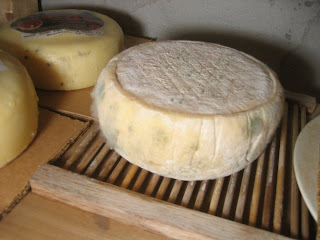The second cheese is a kind of mystery how it turned into what it is. I suspect that I smeared the cheese with Geotrichum candidum, a aerobic fungus which creates a white mold. So far the cheese looks reminiscent of Brie and Camembert.
The third cheese is also developing a smear of B. linens. The cheese younger and harder than the first one.
The last cheese is a hard cheese made with a thermophilic starter and has still some Penicillium roqueforti growth as well as some white molds. I brush this of once in a while to keep the growth under control.










